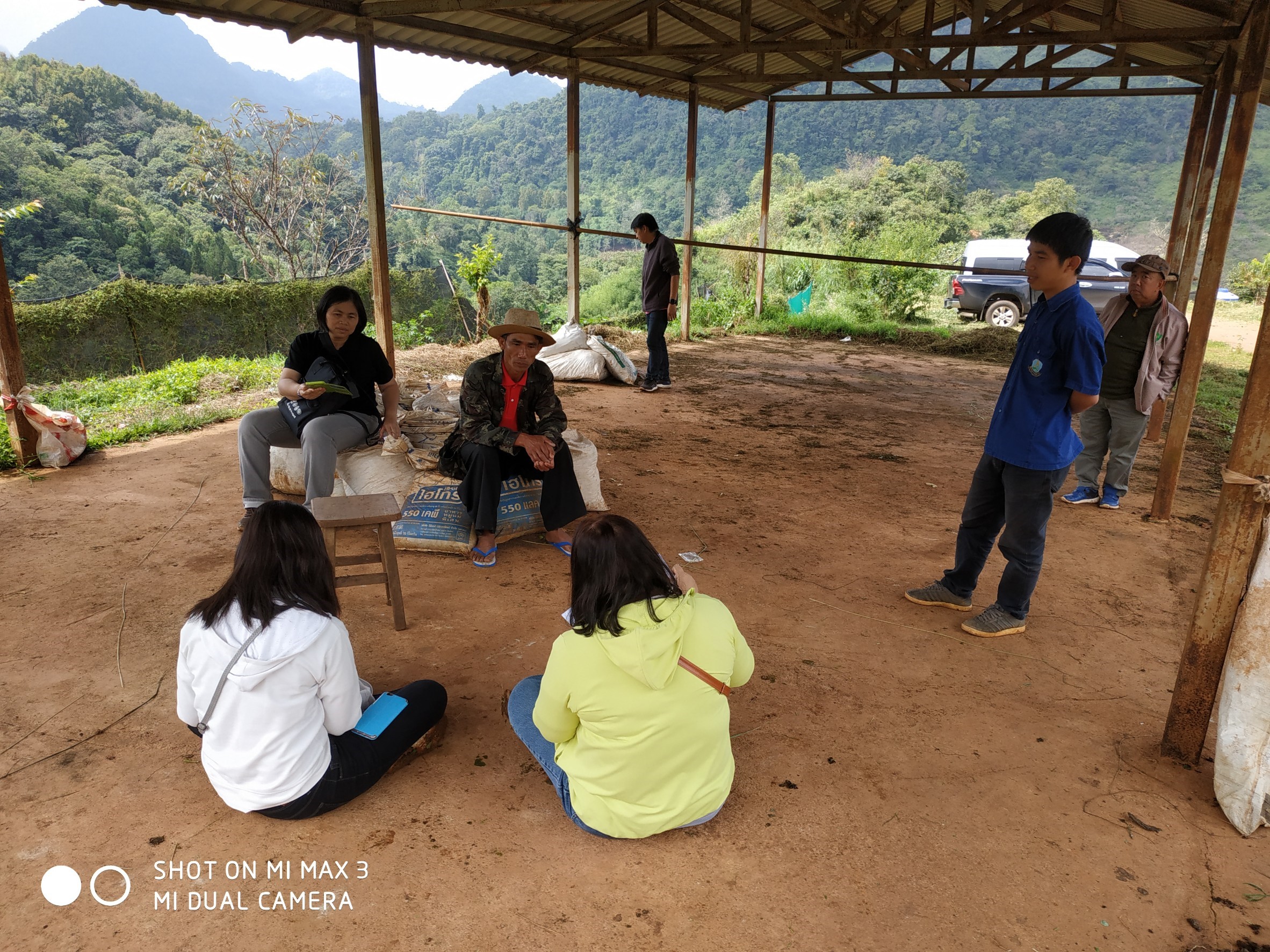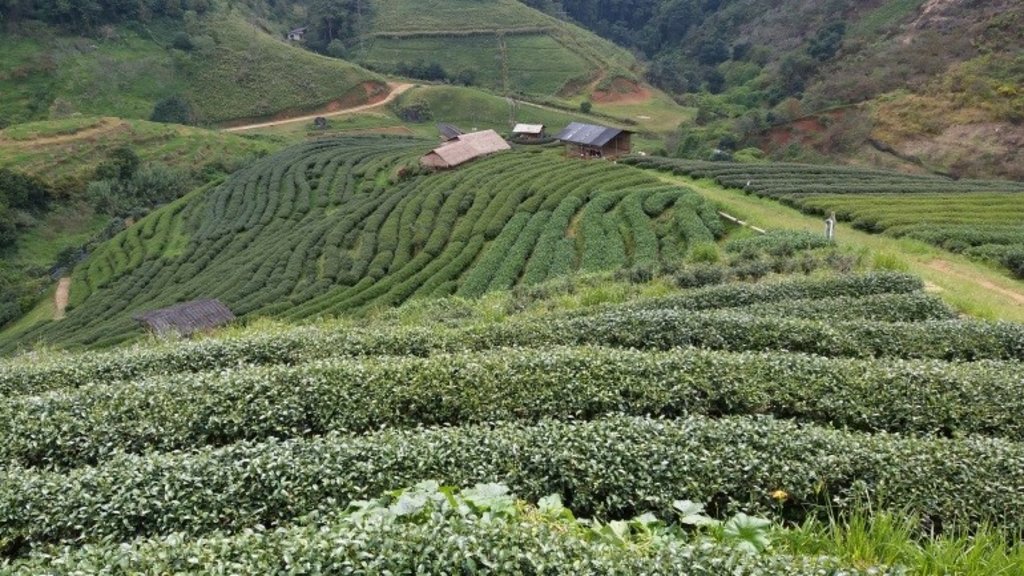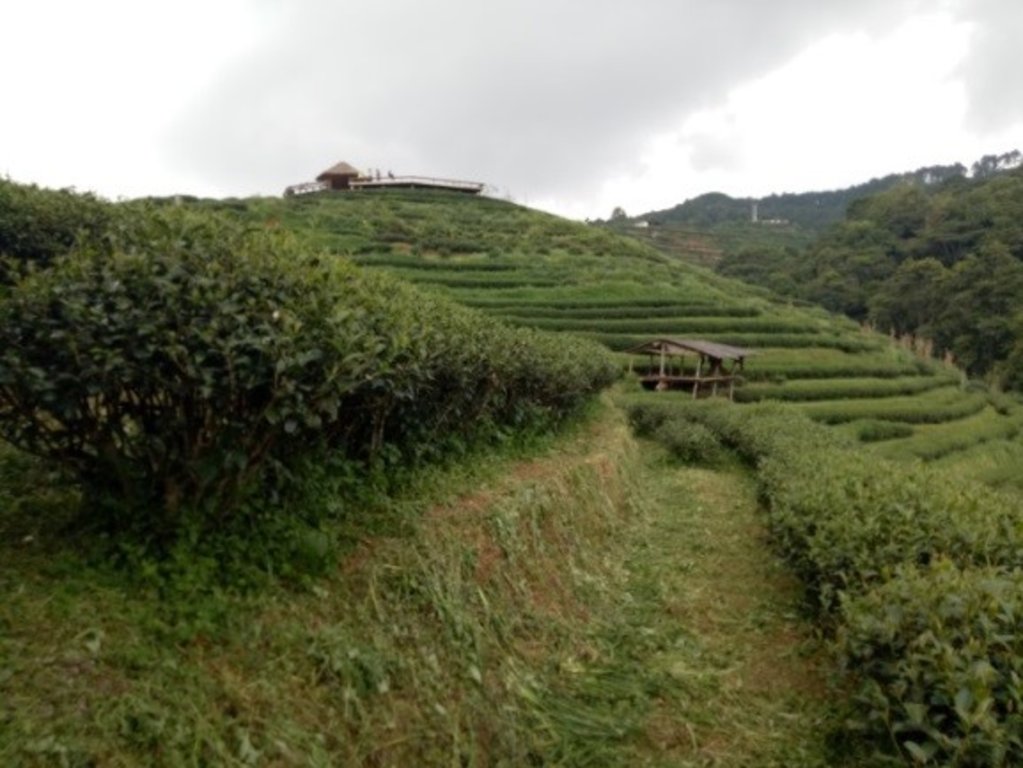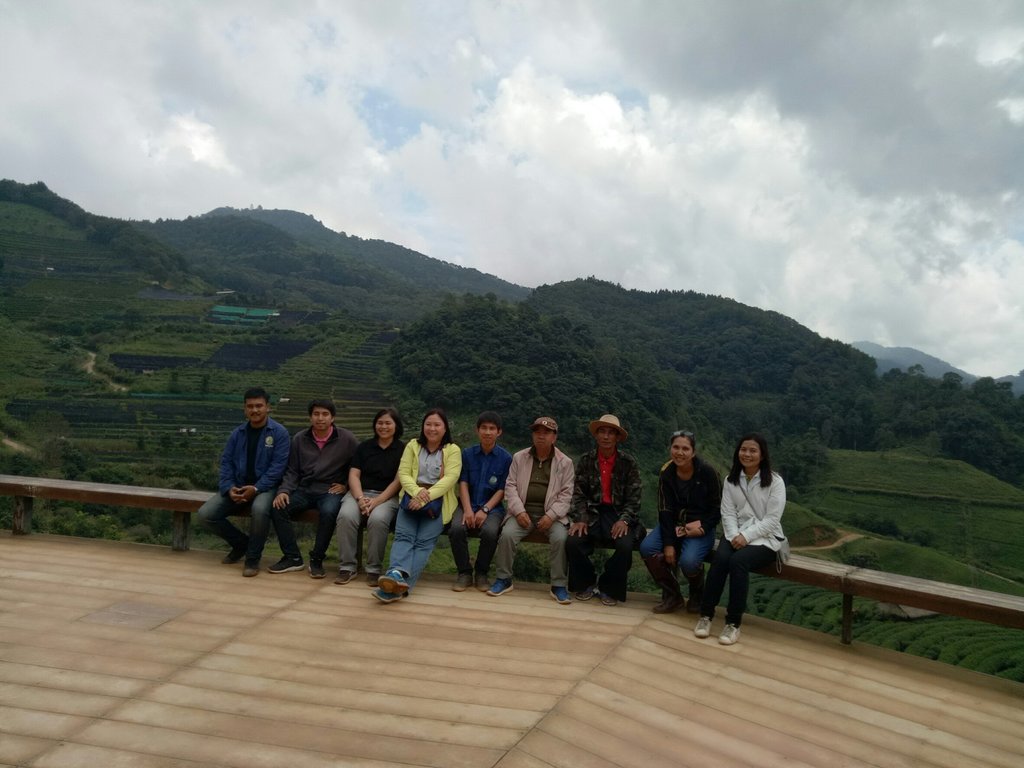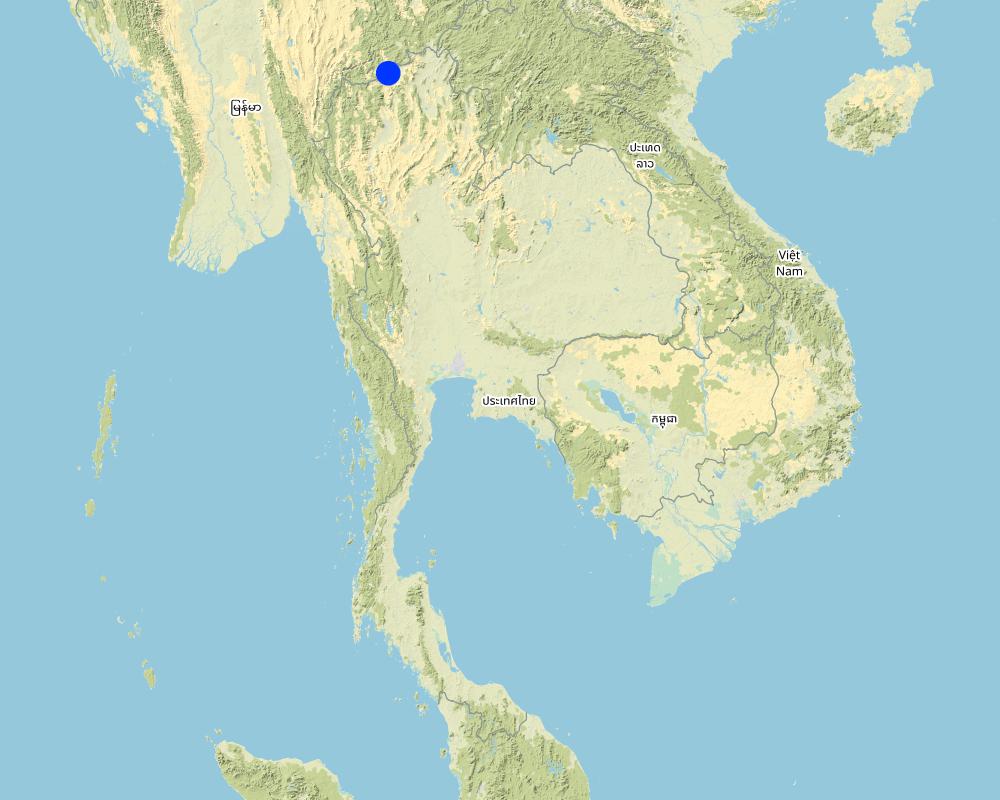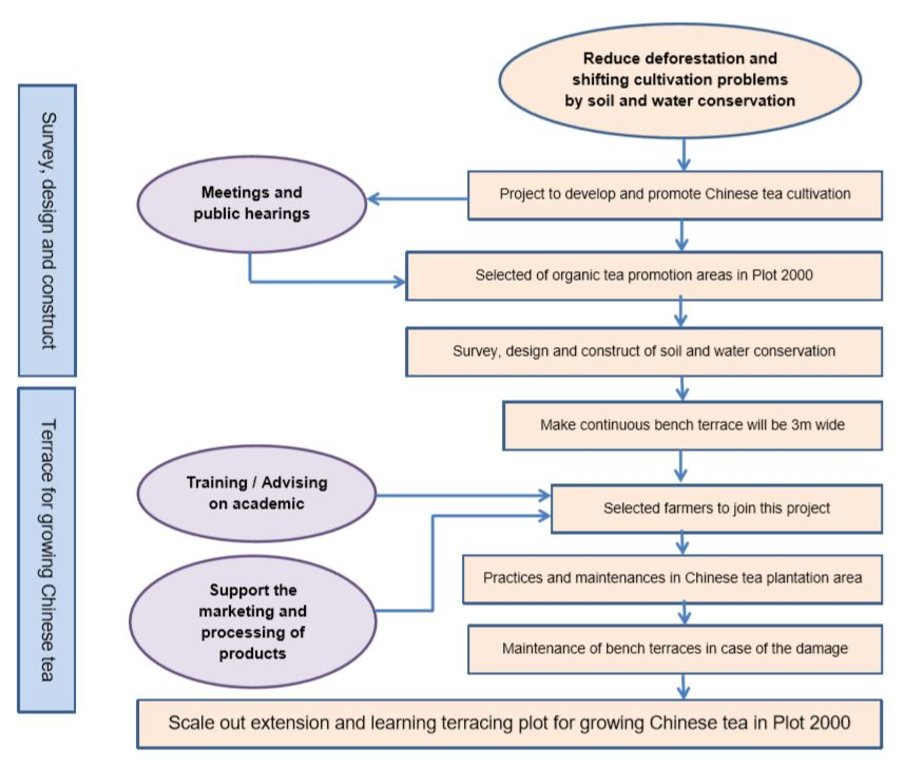Promotion of Organic Tea Production under Bench Terraces [Tailandia]
- Creación:
- Actualización:
- Compilador: Pitayakon Limtong
- Editor: –
- Revisores: Rima Mekdaschi Studer, William Critchley
Continuous bench terrace
approaches_4282 - Tailandia
Visualizar secciones
Expandir todo Colapsar todos1. Información general
1.2 Detalles de contacto de las personas de referencia e instituciones involucradas en la evaluación y la documentación del Enfoque
Persona(s) de referencia clave/s
co-compiler:
Tipvong Tanomkwan
1760 ต่อ 2235 / 0879172421
aoy.tvong.@gmail.com
Land Development Department
Pahotyothin Rd., Chatuchak, Bangkok 10900
Tailandia
Usuario de la tierra:
Mokngoen Jai
0658720601 / -
- / -
Palaung hill tribe, land user in Plot 2000
Mu 5, Khum village, Mae Ngon sub-district, Fang district, Chiang Mai province, 50110
Tailandia
Tapangtong Werapong
0987488087 / -
- / -
Angkhang Royal Agricultural Station
Mu 5, Khum village, Mae Ngon sub-district, Fang district, Chiang Mai province, 50110
Tailandia
Boonchoo Sontaya
- / -
- / -
Royal Project Land Development Center, Land Development Department
164 Mu 3, Chiang Mai-Fang Road, Don Kaeo subdistrict, Mae Rim district, Chiang Mai province, 50180
Tailandia
Nombre de la(s) institución(es) que facilitaron la documentación/ evaluación del Enfoque si fuera relevante)
Land Development Department (Land Development Department) - Tailandia1.3 Condiciones referidas al uso de datos documentados mediante WOCAT
¿Cuándo se compilaron los datos (en el campo)?
19/10/2018
El compilador y la/s persona(s) de referencia claves aceptan las condiciones acerca del uso de los datos documentados mediante WOCAT :
Sí
2. Descripción del Enfoque MST
2.1 Breve descripción del Enfoque
Promotion of continuous bench terraces for sustainable tea plantations in steep areas of the northern region highlands.
2.2 Descripción detallada del Enfoque MST
Descripción detallada del Enfoque MST:
The approach is to develop and promote sustainable agriculture on steep slopes by establishing continuous bench terraces. Under this system, hilltribe farmers can produce good quality Chinese tea, and send their product to a processing factory nearby, which will create stable and high incomes and raise the quality of life. This production/ conservation system aims also to reduce deforestation and shifting cultivation problems, which lead to the degradation of soil and land. As such, soil and water conservation in this upstream sloping highland should promote and encourage appropriate sustainable land management to preserve natural resources and the environment.
In the early stage, Angkhang Royal Agricultural Station initiated this project to develop and promote Chinese tea cultivation on steep land, with close cooperation from the Land Development Department (LDD) to design the continuous bench terraces instead of the cold-climate fruit trees, which had greatly deteriorated. Local officers had allocated land (without ownership) to Palaung hilltribe people who were selected and guaranteed by the community leader for their aptitude and ability to cultivate Chinese tea according to the Good Agricultural Practices (GAP) Guidelines, and set up a Chinese tea producers group at Plot 2000. Angkhang Royal Agricultural Station organized this programme and trained them and also arranged for some local officers to advise on soil management, fertilizer use, and disease and pest control. Vetiver grass planting was introduced to maintain the terrace and road edges; compost was produced to use for improving soil properties and reducing their production cost, and cultivation materials were supplied to all land users through disbursement under the management of Doi Angkhang Agricultural Cooperatives. Local officers also supported marketing through purchasing at the guaranteed price according to the quality of the tea, and set up tea processing factories in this area. The project encourages all land users to observe and maintain their tea bushes and the land around them. Currently all land users are aware of how to sustainably use and maintain their land and soil resources. Moreover, local officers advise how to repair bench terraces themselves; however, if the damage is serious, the LDD officers will come in to help them repair.
2.3 Fotos del Enfoque
Comentarios generales sobre las fotos:
Data collection supports for mainstreaming and scaling-up of sustainable land management
2.4 Videos del Enfoque
Comentarios, descripción breve:
Tea plantation in soil and water conservation measure in steep areas
Fecha:
09/10/2018
Lugar:
Doi Ang Khang
Nombre del videógrafo:
Ms. Somjit Lertdisayawan / Ms. Tanomkwan Tipvong
Comentarios, descripción breve:
Tea plantation farm
Fecha:
21/01/2016
Lugar:
Doi Angkhang
Nombre del videógrafo:
Pornthep Molee
Comentarios, descripción breve:
Angkhang Royal Agricultural Station
39 เส้นทาง เรียนรู้ ทำดี “ตามรอยพ่อ”
Fecha:
15/03/2017
Lugar:
Angkhang Royal Agricultural Station
Nombre del videógrafo:
Royal Project Foundation, Ford Thailand
2.5 País/ región/ lugares donde el Enfoque fue aplicado
País:
Tailandia
Región/ Estado/ Provincia:
Chiang Mai Province
Especifique más el lugar :
Extension area for Chinese tea plantation (Farm 2000) at Angkhang Royal Agricultural Station, Mae Ngon Sub-district, Fang District,Chiang Mai Province
Comentarios:
Angkhang Royal Agricultural Station is the main agency to assist, support and encourage hilltribe farmers in protection and awareness of soil resources in this steep zone. Soil and water conservation measures have been used to solve the erosion problem, protect the environment, preserve the forest and enable land users to grow the Chinese tea in this area ("Farm 2000").
Map
×2.6 Fechas de inicio y conclusión del Enfoque
Indique año del inicio:
1999
Si no se conoce el año preciso, indique la fecha aproximada en la que se inició el Enfoque:
10-50 años atrás
Comentarios:
Sustainable use of a steep area. Hill tribe farmers can utilize this continuous bench terrace land for tea plantation or other purposes for long time under GAP system.
2.7 Tipo de Enfoque
- proyecto/ basado en un programa
2.8 Propósitos/ objetivos principales del Enfoque
The first objective is to enable hilltribe farmers, through suitable soil and water conservation measures, to produce good quality Chinese tea on the highland. The second objective is to create a stable income and raise the quality of life, where it is very important to ensure sustainable landuse without damaging natural resources and the environment. The third is to reduce forest encroachment problems in the highland and watershed areas of the northern region of Thailand.
2.9 Condiciones que facilitan o impiden la implementación de la/s Tecnología/s aplicadas bajo el Enfoque
disponibilidad/ acceso a recursos y servicios financieros
- facilitan
Angkhang Agricultural Cooperatives supported production factors to land users and cooperatives officers will monitor and evaluate this process.
entorno institucional
- facilitan
Land user network as cooperative of tea plantation group with cooperation in compost or organic fertilizers production
marco de trabajo legal (tenencia de tierra, derechos de uso de tierra y agua)
- facilitan
Almost land users did not have right in land ownership, but they have right to use the allocated land, which these land are allocated by the Royal Project.
políticas
- facilitan
Government policy and Royal project supported the budget and implementation activities
gobernanza de tierras (toma de decisiones, implementación y aplicación)
- facilitan
Royal project and government agencies regulated land use planning and take care on soil and land management in this area.
conocimiento de MST, acceso a apoyo técnico
- facilitan
The officers of Angkhang Royal Agricultural Station advise land users to manage soil and land, including tea production and process.
mercados (para comprar insumos, vender productos) y precios
- facilitan
They have tea processing factories in this area.
otros
- facilitan
3. Participación y roles de las partes interesadas involucradas
3.1 Partes interesadas involucradas en el Enfoque y sus roles
- usuarios locales de tierras/ comunidades locales
All farmers belong to the hilltribe Palaung ethnic group.
All land users take care of bench terraces with advice from station officers.
- organizaciones comunitarias
Angkhang Royal Agricultural Station, The Royal Project
The station officers extend and promote the occupation, encourage and advise in technology transfer the technical matter and knowledge to farmers.
- profesores/ niños en edad escolar/ estudiantes
School children and students
Training course and study tour in the area
- gobierno local
Several local government agencies are directly involved in this process, including officers from the station and the Royal Project.
The station officers extend and promote the occupation, encourage and advise the farmers in technical knowledge, support production facilities and processing factory.
- gobierno nacional (planificadores, autoridades)
Administrative officers in department and ministry level
Making decisions and creating policy
3.2 Involucramiento de los usuarios locales de tierras/ comunidades locales en las distintas fases del Enfoque
| Involucramiento de los usuarios locales de tierras/ comunidades locales | Especifique quién se involucró y describa las actividades | |
|---|---|---|
| iniciación/ motivación | interactivo | Angkhang Royal Agricultural Station created continuous bench terraces as a soil and water conservation measure in the former degraded cold-climate fruit tree plot. They informed all land users about land allocation and zoning for suitable economic crops and trees, including Chinese tea in Plot 2000. |
| planificación | interactivo | Almost all land users (Palaung hilltribe) have been allocated land for planting Chinese tea with good agricultural practices (GAP) system in Plot 2000. |
| implementación | ninguno | The LDD has been responsible for conducting soil and land survey, designing and constructing soil and water conservation measures, with close collaboration with Angkhang Royal Agricultural Station. |
| monitoreo y evaluación | interactivo | All Palaung hilltribe land users in this area have to maintain/repair the bench terraces in their allocated land. |
3.3 Flujograma (si estuviera disponible)
Descripción:
Flow chart Operating procedures of bench terrace:
1. The organic Chinese tea plantation project is emphasized to promote and develop career of hilltribe people around the area of Angkhang Royal Agricultural Station to reduce forest encroachment and shifting cultivation and encourage them to use the land in a sustainable way with stable and high income.
2. Angkhang Royal Agricultural Station has selected the area of old cold-climate crops where soil has deteriorated; the station officers need to reshape the land and construct suitable conservation measures in this sloping area.
3. In 1999, Land Development Department (LDD) supported in the survey, design and construction of soil and water conservation measures as continuous bench terraces. The distance between two terraces and the vertical interval (VI) depend on the slope of the area, but the cultivation area of each terrace will be 3m wide.
4. The Angkhang Royal Agricultural Station has selected farmers to join this project by considering their aptitude, ability and opportunity for further development in organic Chinese tea plantation. Almost all land users have been approved by community leaders to practice and implement following the instruction from extension officers.
5. All selected land users should practice and maintenance as recommended by station officers. In planting tea, farmers will dig a small furrow along the terrace around 30cm deep and 30cm wide. Tea seedlings will be planted in the furrow with a spacing of 40-50 cm between trees (around 2,000 plants/rai). Surface soil around these tea seedlings will be mulched to maintain suitable soil moisture.
6. Farmers will produce organic Chinese tea so they need to avoid applying chemical fertilizers and other chemical substances, but limit the use only to natural materials. Compost is applied at a rate of 2 kg/tree along both sides of the tea canopy, and incorporated about 15 cm below the soil surface. This compost rate may be applied 3 times a year.
7. The Chinese tea is usually harvested from April to December, and will receive nourishment/maintenance ( January-March). At present, the No. 12 variety has an average yield of 800 kg/rai, with some 5-6 harvests a year, while the soft stem variety has an average yield of 600 kg/rai, with some 4-5 harvests a year. The station has received a budget from the Taiwanese government and the Institute of Highland Area Development to support the processing factory building, machinery and necessary techniques.
8. Maintenance of damaged bench terraces: all land users will repair by themselves in the dry season. In the serious case of erosion, the LDD will support such maintenance. In addition, vetiver grass is planted to strengthen the edge of the terraces.
Autor:
Ms.Tanomkwan Tipvong
3.4 La toma de decisiones en la selección de Tecnología(s) MST
Especifique quién decidió la selección de las Tecnología/ Tecnologías a implementarse:
- todos los actores relevantes, como parte de un enfoque participativo
Explique:
-
Especifique las bases que sustentaron la toma de decisiones:
- la evaluación de conocimiento MST bien documentado (la toma de decisiones se basa en evidencia)
- Policies and legal measures
4. Apoyo técnico, fortalecimiento institucional y gestión del conocimiento
4.1 Construcción de capacidades / capacitación
¿Se proporcionó la capacitación a usuarios de tierras/ otras partes interesadas?
Sí
Especifique quién fue capacitado:
- usuarios de tierras
Si fuese relevante, también especifique género, edad, estatus, etnicidad, etc.
Both male and female
Forma de capacitación:
- de agricultor a agricultor
- áreas de demostración
Forma de capacitación:
- Mmonthly meeting
Temas avanzados:
Implementation activities, how to solve some problems, maintain and repair conservation measure, vetiver grass plantation and others
Comentarios:
-
4.2 Servicio de asesoría
¿Los usuarios de tierras tienen acceso a un servicio de asesoría?
Sí
Especifique si servicio proporcionado se realizó:
- en los campos de los usuarios de tierras
- en centros permanentes
Describa/ comentarios:
-
4.3 Fortalecimiento institucional (desarrollo institucional)
¿Se establecieron o fortalecieron instituciones mediante el Enfoque?
- sí, mucho
Especifique el nivel o los niveles en los que se fortalecieron o establecieron las instituciones:
- local
Describa la institución, roles y responsabilidades, miembros, etc.
All land users (from the Palaung hilltribe) have been selected as members to promote and implement organic Chinese tea plantation with their awareness to maintain and take care of conservation measures for sustainable use of this land.
Especifique el tipo de apoyo:
- financiero
- budget in repair structure
Proporcione detalles adicionales:
The Angkhang station gives a support budget to repair the bench terrace about 500 baht per rai.
4.4 Monitoreo y evaluación
¿El monitoreo y la evaluación forman parte del Enfoque?
Sí
Comentarios:
Angkhang Royal Agricultural Station set up a monitoring and evaluation programme for the Chinese tea cultivation under bench terraces.
Si respondió que sí, ¿la documentación se utilizará para monitoreo y evaluación?
Sí
Comentarios:
-
4.5 Investigación
¿La investigación formó parte del Enfoque?
No
5. Financiamiento y apoyo material externo
5.2 Apoyo financiero/material proporcionado a los usuarios de tierras
¿Los usuarios de tierras recibieron financiamiento/ apoyo material para implementar la Tecnología/ Tecnologías? :
Sí
Si respondió sí, especifique el tipo o los tipos de apoyo, condiciones y proveedor(es) :
LDD support with the supply of vetiver grass slips and technology to maintain the terrace including support the budget to repair terraces at 500 baht per rai per year.
5.3 Subsidios para insumos específicos (incluyendo mano de obra)
- mano de obra
| En qué grado | Especifique los subsidios |
|---|---|
| parcialmente financiado | Maintain and repair budget around 500 baht per rai. |
Si la mano de obra de usuarios de tierras fue un insumo sustancial, ¿fue:
- voluntario?
Comentarios:
-
5.4 Crédito
¿Se proporcionó crédito bajo el Enfoque para actividades MST?
Sí
Especifique las condiciones (tasa de interés el apoyo, amortización, etc.):
No interest
Especifique los proveedores de crédito:
Cooperatives of Angkaung Royal Agricultural Station support in production materials
Especifique los destinatarios del crédito :
All land users are members of this cooperatives.
5.5 Otros incentivos o instrumentos
¿Se usaron otros incentivos o instrumentos para promover la implementación de Tecnologías MST?
No
6. Análisis de impacto y comentarios de conclusión
6.1 Impactos del Enfoque
¿El Enfoque ayudó a los usuarios de tierras a implementar y mantener Tecnologías MST?
- No
- Sí, un poco
- Sí, moderadamente
- Sí, mucho
Almost land users are good in maintaining and repairing this terrace system.
¿El Enfoque mejoró la coordinación e implementación efectiva en costos de MST?
- No
- Sí, un poco
- Sí, moderadamente
- Sí, mucho
They collaborate closely with local officers.
¿El Enfoque mejoró el conocimiento y capacidades de los usuarios para implementar MST?
- No
- Sí, un poco
- Sí, moderadamente
- Sí, mucho
They cannot construct this terrace by themselves, but can maintain and repair the damaged areas. They know and understand the benefit and effectiveness of this measure.
¿El Enfoque mejoró cuestiones de tenencia de tierra/ derechos de usuarios que obstaculizaron la implementación de la Tecnologías MST?
- No
- Sí, un poco
- Sí, moderadamente
- Sí, mucho
They cannot have right in land ownership but they have rights in land tenure and utilize this land for Chinese tea in Plot 2000.
¿El Enfoque llevó a un uso más sostenible/ fuentes de energía?
- No
- Sí, un poco
- Sí, moderadamente
- Sí, mucho
This bench terrace and other land management practices are firmly sustainable for Chinese tea production.
6.2 Motivación principal del usuario de la tierra para implementar MST
- producción incrementada
Harvest of Chinese tea 5-6 times/year and generate more income for land users.
- reducción de la degradación de la tierra
This bench terrace system is effective in reducing soil erosion, runoff and preserving soil fertility and quality.
- afiliación al movimiento/ proyecto/ grupo/ redes
Angkaung Royal Agriculture station set up project of promotion and development.
6.3 Sostenibilidad de las actividades del Enfoque
¿Pueden los usuarios de tierras sostener lo que se implementó mediante el Enfoque (sin apoyo externo)?
- incierto
Si respondió no o incierto, especifique y comente:
All land users need to work within the guideline of this project, maintain and repair the terrace, take care of Chinese tea until the period of harvest, and also soil and land fertility improvement.
6.4 Fortalezas/ ventajas del Enfoque
| Fuerzas/ ventajas/ oportunidades desde la perspectiva del usuario de la tierra |
|---|
| The continuous bench terrace is a highly effective measure to slow down runoff, and thus reduces soil erosion. |
| This system would reduce the amount of fertilizer application, as organic matter and plant nutrients still stay in the sloping area. |
| All land users can produce more agricultural products, thus will receive more income. |
| Fuerzas/ ventajas/ oportunidades desde la perspectiva del compilador o de otra persona de referencia clave |
|---|
| The bench terrace increases the amount of water to store in the soil, while the excessive amount of rain would gradually drain through the waterway. |
| This technology would reduce the amount of fertilizer application as it prevents plant nutrients from escaping from the area. |
| All land users can improve their life quality from increasing agricultural products/income. |
6.5 Debilidades/ desventajas del Enfoque y formas de sobreponerse a ellos
| Debilidades/ desventajas/ riesgos desde la perspectiva del usuario de la tierra | ¿Cómo sobreponerse a ellas? |
|---|---|
| The cost for constructing continuous bench terraces is very high. | It is possible only when the government and local officers support these activities. |
| The system needs expert in design and implementation. | Local government officers (LDD) support and perform these activities. |
| When the structure of bench terraces is damaged. | Local government officers (LDD) will help in doing the repair. |
| Debilidades/ desventajas/ riesgos desde la perspectiva del compilador o de otra persona de referencia clave | ¿Cómo sobreponerse a ellas? |
|---|---|
| The cost for constructing bench terraces is very high, heavy machines are needed. | Government and local officers support these activities. |
| The system needs expert in doing the design and implementation. | Local government officers (LDD) support and perform these activities. |
| When the structure of bench terraces is damaged by heavy rain, runoff and other events. | Local government officers (LDD) support its reparation. |
7. Referencias y vínculos
7.1 Métodos/ fuentes de información
- visitas de campo, encuestas de campo
3
- entrevistas con usuarios de tierras
1
- entrevistas con especialistas/ expertos en MST
2
- compilación de informes y otra documentación existente
1
7.2 Referencias a publicaciones disponibles
Título, autor, año, ISBN:
-
¿Dónde se halla disponible? ¿Costo?
-
7.3 Vínculos a la información relevante disponible en línea
Título/ descripción:
การทำขั้นบันไดดินเพื่อการอนุรักษ์ดินและน้ำในพื้นที่ป่าต้นน้ำลำธาน (ความลาดชัน 35-60%)
URL:
http://www.dnp.go.th/watershed/ ส่วนอำนวยการ/จัดทำระบบอนุรักษ์ดินและน้ำ โครงการทำขั้นบันไดดิน.pdf
Vínculos y módulos
Expandir todo Colapsar todosVínculos
No hay vínculos
Módulos
No se hallaron módulos


